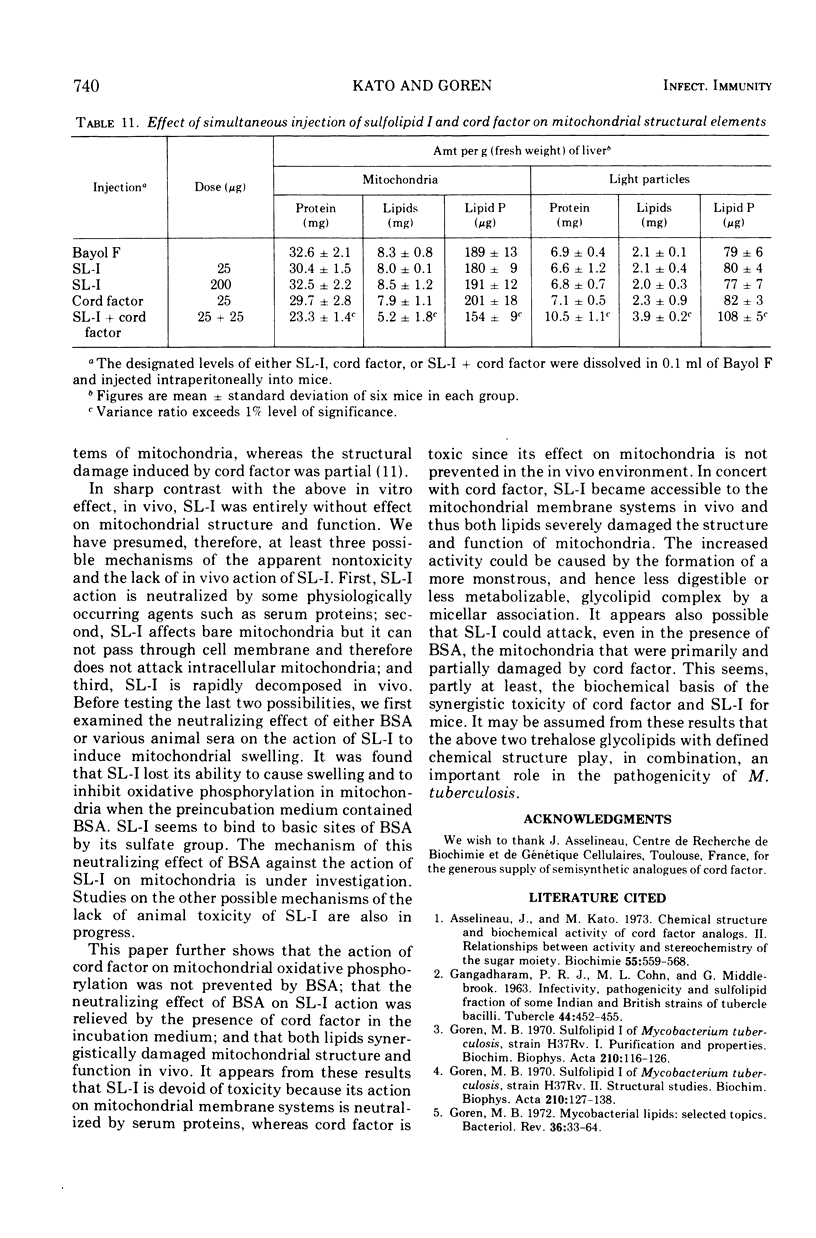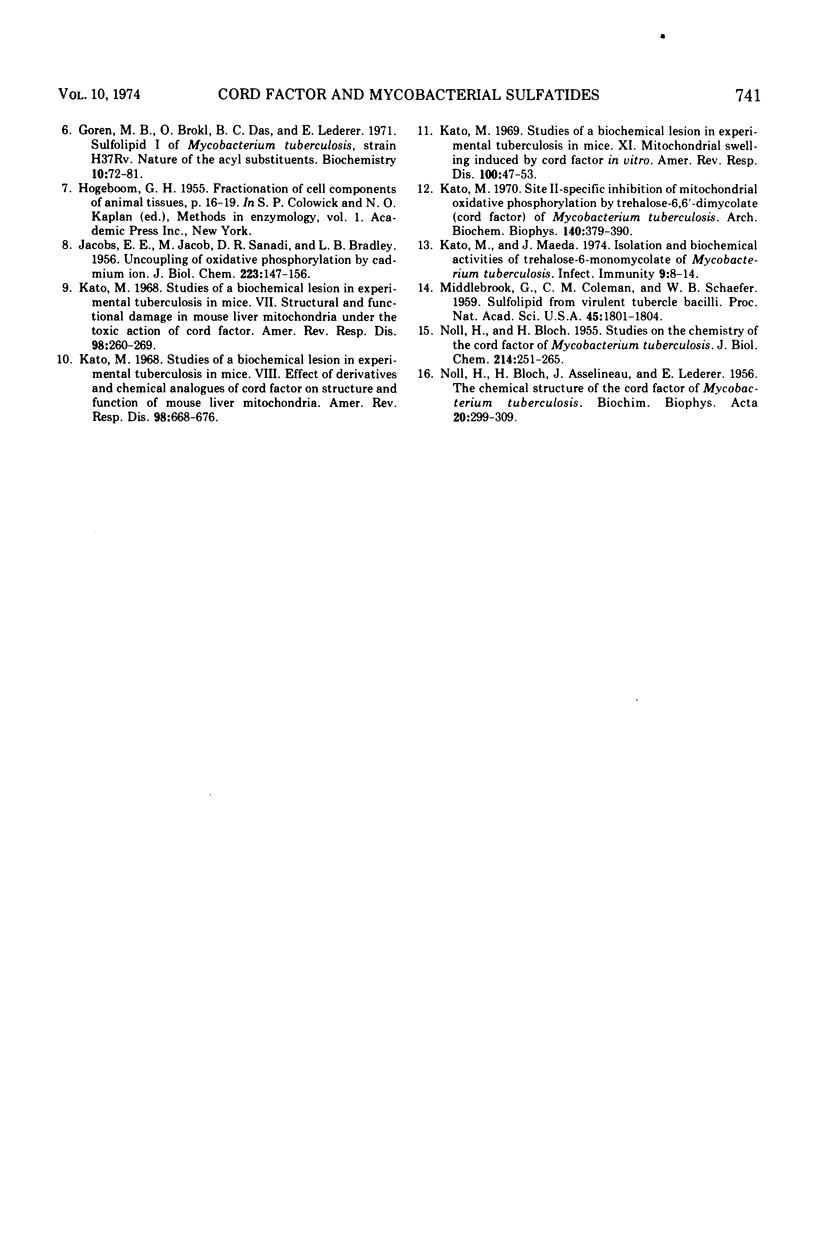Abstract
The mechanism of a synergistic toxicity of 6,6′-dimycoloyl-α,α′-d-trehalose (cord factor) and 2,3,6,6′-tetraacyl-α,α′-d-trehalose 2′-sulfate (sulfolipid I) for mice was studied. Sulfolipid I was entirely nontoxic, but it markedly accelerated the lethal toxicity of cord factor for mice. In vivo, sulfolipid I affected neither respiration nor accompanying phosphorylation of mouse liver mitochondria, whereas in vitro, it induced a swelling and disruption of mitochondrial membranes and strongly inhibited mitochondrial oxidative phosphorylation. The effect of sulfolipid I on mitochondrial structure and function in vitro was neutralized by bovine serum albumin and various animal sera, whereas that of cord factor and cord factor plus sulfolipid I was not prevented by bovine serum albumin. The simultaneous injection of cord factor and sulfolipid I caused an intensive fragmentation of mitochondria and a marked decrease in respiratory and phosphorylative activity in mitochondria. These data indicate that sulfolipid I can achieve an effective attack on mitochondria in combination with cord factor in vivo and induces heavier damage in mitochondrial structure and function than that produced by cord factor alone.
Full text
PDF








Selected References
These references are in PubMed. This may not be the complete list of references from this article.
- Asselineau J., Kato M. Chemical structure and biochemical activity of cord factor analogs. 2. Relationships between activity and stereochemistry of the sugar moiety. Biochimie. 1973 May;55(5):559–568. doi: 10.1016/s0300-9084(73)80416-x. [DOI] [PubMed] [Google Scholar]
- BRADLEY L. B., JACOB M., JACOBS E. E., SANADI D. R. Uncoupling of oxidative phosphorylation by cadmium ion. J Biol Chem. 1956 Nov;223(1):147–156. [PubMed] [Google Scholar]
- GANGADHARAM P. R., COHN M. L., MIDDLEBROOK G. INFECTIVITY, PATHOGENICITY AND SULPHOLIPID FRACTION OF SOME INDIAN AND BRITISH STRAINS OF TUBERCLE BACILLI. Tubercle. 1963 Dec;44:452–455. doi: 10.1016/s0041-3879(63)80087-2. [DOI] [PubMed] [Google Scholar]
- Goren M. B., Brokl O., Das B. C., Lederer E. Sulfolipid I of Mycobacterium tuberculosis, strain H37RV. Nature of the acyl substituents. Biochemistry. 1971 Jan 5;10(1):72–81. doi: 10.1021/bi00777a012. [DOI] [PubMed] [Google Scholar]
- Goren M. B. Mycobacterial lipids: selected topics. Bacteriol Rev. 1972 Mar;36(1):33–64. doi: 10.1128/br.36.1.33-64.1972. [DOI] [PMC free article] [PubMed] [Google Scholar]
- Goren M. B. Sulfolipid I of Mycobacterium tuberculosis, strain H37Rv. I. Purification and properties. Biochim Biophys Acta. 1970 Jun 9;210(1):116–126. doi: 10.1016/0005-2760(70)90067-6. [DOI] [PubMed] [Google Scholar]
- Goren M. B. Sulfolipid I of Mycobacterium tuberculosis, strain H37Rv. II. Structural studies. Biochim Biophys Acta. 1970 Jun 9;210(1):127–138. doi: 10.1016/0005-2760(70)90068-8. [DOI] [PubMed] [Google Scholar]
- Kato M., Maeda J. Isolation and biochemical activities of trehalose-6-monomycolate of Mycobacterium tuberculosis. Infect Immun. 1974 Jan;9(1):8–14. doi: 10.1128/iai.9.1.8-14.1974. [DOI] [PMC free article] [PubMed] [Google Scholar]
- Kato M. Site II-specific inhibition of mitochondria oxidative phosphorylation by trehalose-6,6'-dimycolate (cord factor) of Mycobacterium tuberculosis. Arch Biochem Biophys. 1970 Oct;140(2):379–390. doi: 10.1016/0003-9861(70)90079-2. [DOI] [PubMed] [Google Scholar]
- Kato M. Studies of a biochemical lesion in experimental tuberculosis in mice. 8. Effect of derivatives and chemical analogues of cord factor on structure and function of mouse liver mitochondria. Am Rev Respir Dis. 1968 Oct;98(4):668–676. doi: 10.1164/arrd.1968.98.4.668. [DOI] [PubMed] [Google Scholar]
- Kato M. Studies of a biochemical lesion in experimental tuberculosis in mice. VII. Structural and functional damage in mouse liver mitochondria under the toxic action of cord factor. Am Rev Respir Dis. 1968 Aug;98(2):260–269. doi: 10.1164/arrd.1968.98.2.260. [DOI] [PubMed] [Google Scholar]
- Kato M. Studies of a biochemical lesion in experimental tuberculosis in mice. XI. Mitochondrial swelling induced by cord factor in vitro. Am Rev Respir Dis. 1969 Jul;100(1):47–53. doi: 10.1164/arrd.1969.100.1.47. [DOI] [PubMed] [Google Scholar]
- Middlebrook G., Coleman C. M., Schaefer W. B. SULFOLIPID FROM VIRULENT TUBERCLE BACILLI. Proc Natl Acad Sci U S A. 1959 Dec;45(12):1801–1804. doi: 10.1073/pnas.45.12.1801. [DOI] [PMC free article] [PubMed] [Google Scholar]
- NOLL H., BLOCH H., ASSELINEAU J., LEDERER E. The chemical structure of the cord factor of Mycobacterium tuberculosis. Biochim Biophys Acta. 1956 May;20(2):299–309. doi: 10.1016/0006-3002(56)90289-x. [DOI] [PubMed] [Google Scholar]
- NOLL H., BLOCH H. Studies on the chemistry of the cord factor of Mycobacterium tuberculosis. J Biol Chem. 1955 May;214(1):251–265. [PubMed] [Google Scholar]


